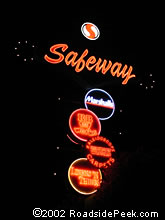not to be confused with Google
Near our house here in sunny, er cloudy California is my favorite (non-natural) grocery store. It's my favorite not only because it's humongous and being from Dallas, I love big, but also because of the rockin' sign:

Blessed be the man who talked the developers into repurposing the old Futurama sign!
 Photo from Alan Hess's Googie
Photo from Alan Hess's Googie
We love this style of design and architecture. And I learned it has a name:

Blessed be the man who talked the developers into repurposing the old Futurama sign!
 Photo from Alan Hess's Googie
Photo from Alan Hess's GoogieWe love this style of design and architecture. And I learned it has a name:
Googie, n.
Googie, also known as populuxe, is a subdivison of futurist architecture influenced by car culture and the Space Age, originating from southern California in the late 1940s and continuing approximately into the mid-1960s. With upswept roofs and, often, curvaceous, geometric shapes, and bold use of glass, steel and neon, it decorated many a motel, coffee house and bowling alley in the 1950s and 1960s. It epitomizes the spirit a generation demanded, looking excitedly towards a bright, technological and futuristic age.
Douglas Haskell, a professor at Yale University, coined the term "Googie" architecture in 1952 and defined it by these principles:
1. It can look organic, but it must be abstract. "If it looks like a bird, it must be a geometric bird. It's better yet if the house had more than one theme: like an abstract mushroom surmounted by an abstract bird."
2. Ignore gravity altogether. "Whenever possible, the building must hang from the sky."
3. Multiple structural elements. Inclusion is the rule, rather than minimalism.


<< Home